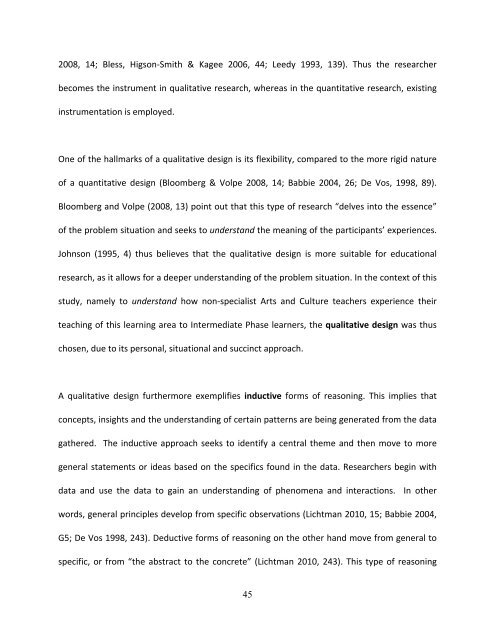Elaine Browne.pdf - Nelson Mandela Metropolitan University
Elaine Browne.pdf - Nelson Mandela Metropolitan University
Elaine Browne.pdf - Nelson Mandela Metropolitan University
Create successful ePaper yourself
Turn your PDF publications into a flip-book with our unique Google optimized e-Paper software.
2008, 14; Bless, Higson‐Smith & Kagee 2006, 44; Leedy 1993, 139). Thus the researcher<br />
becomes the instrument in qualitative research, whereas in the quantitative research, existing<br />
instrumentation is employed.<br />
One of the hallmarks of a qualitative design is its flexibility, compared to the more rigid nature<br />
of a quantitative design (Bloomberg & Volpe 2008, 14; Babbie 2004, 26; De Vos, 1998, 89).<br />
Bloomberg and Volpe (2008, 13) point out that this type of research “delves into the essence”<br />
of the problem situation and seeks to understand the meaning of the participants’ experiences.<br />
Johnson (1995, 4) thus believes that the qualitative design is more suitable for educational<br />
research, as it allows for a deeper understanding of the problem situation. In the context of this<br />
study, namely to understand how non‐specialist Arts and Culture teachers experience their<br />
teaching of this learning area to Intermediate Phase learners, the qualitative design was thus<br />
chosen, due to its personal, situational and succinct approach.<br />
A qualitative design furthermore exemplifies inductive forms of reasoning. This implies that<br />
concepts, insights and the understanding of certain patterns are being generated from the data<br />
gathered. The inductive approach seeks to identify a central theme and then move to more<br />
general statements or ideas based on the specifics found in the data. Researchers begin with<br />
data and use the data to gain an understanding of phenomena and interactions. In other<br />
words, general principles develop from specific observations (Lichtman 2010, 15; Babbie 2004,<br />
G5; De Vos 1998, 243). Deductive forms of reasoning on the other hand move from general to<br />
specific, or from “the abstract to the concrete” (Lichtman 2010, 243). This type of reasoning<br />
45

















